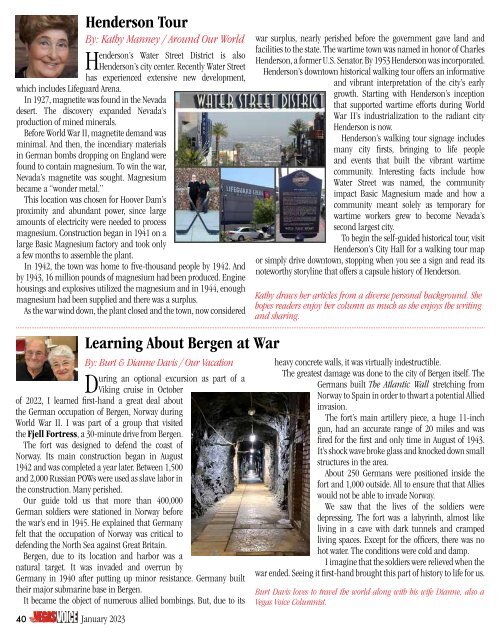Create successful ePaper yourself
Turn your PDF publications into a flip-book with our unique Google optimized e-Paper software.
Henderson Tour<br />
By: Kathy Manney / Around Our World<br />
Henderson’s Water Street District is also<br />
Henderson’s city center. Recently Water Street<br />
has experienced extensive new development,<br />
which includes Lifeguard Arena.<br />
In 1927, magnetite was found in the Nevada<br />
desert. The discovery expanded Nevada’s<br />
production of mined minerals.<br />
Before World War II, magnetite demand was<br />
minimal. And then, the incendiary materials<br />
in German bombs dropping on England were<br />
found to contain magnesium. To win the war,<br />
Nevada’s magnetite was sought. Magnesium<br />
became a “wonder metal.”<br />
This location was chosen for Hoover Dam’s<br />
proximity and abundant power, since large<br />
amounts of electricity were needed to process<br />
magnesium. Construction began in 1941 on a<br />
large Basic Magnesium factory and took only<br />
a few months to assemble the plant.<br />
In 1942, the town was home to five-thousand people by 1942. And<br />
by 1943, 16 million pounds of magnesium had been produced. Engine<br />
housings and explosives utilized the magnesium and in 1944, enough<br />
magnesium had been supplied and there was a surplus.<br />
As the war wind down, the plant closed and the town, now considered<br />
war surplus, nearly perished before the government gave land and<br />
facilities to the state. The wartime town was named in honor of Charles<br />
Henderson, a former U.S. Senator. By 1953 Henderson was incorporated.<br />
Henderson’s downtown historical walking tour offers an informative<br />
and vibrant interpretation of the city’s early<br />
growth. Starting with Henderson’s inception<br />
that supported wartime efforts during World<br />
War II’s industrialization to the radiant city<br />
Henderson is now.<br />
Henderson’s walking tour signage includes<br />
many city firsts, bringing to life people<br />
and events that built the vibrant wartime<br />
community. Interesting facts include how<br />
Water Street was named, the community<br />
impact Basic Magnesium made and how a<br />
community meant solely as temporary for<br />
wartime workers grew to become Nevada’s<br />
second largest city.<br />
To begin the self-guided historical tour, visit<br />
Henderson’s City Hall for a walking tour map<br />
or simply drive downtown, stopping when you see a sign and read its<br />
noteworthy storyline that offers a capsule history of Henderson.<br />
Kathy draws her articles from a diverse personal background. She<br />
hopes readers enjoy her column as much as she enjoys the writing<br />
and sharing.<br />
By: Burt & Dianne Davis / Our Vacation<br />
During an optional excursion as part of a<br />
Viking cruise in October<br />
of 2022, I learned first-hand a great deal about<br />
the German occupation of Bergen, Norway during<br />
World War II. I was part of a group that visited<br />
the Fjell Fortress, a 30-minute drive from Bergen.<br />
The fort was designed to defend the coast of<br />
Norway. Its main construction began in August<br />
1942 and was completed a year later. Between 1,500<br />
and 2,000 Russian POWs were used as slave labor in<br />
the construction. Many perished.<br />
Our guide told us that more than 400,000<br />
German soldiers were stationed in Norway before<br />
the war’s end in 1945. He explained that Germany<br />
felt that the occupation of Norway was critical to<br />
defending the North Sea against Great Britain.<br />
Bergen, due to its location and harbor was a<br />
natural target. It was invaded and overrun by<br />
Germany in 1940 after putting up minor resistance. Germany built<br />
their major submarine base in Bergen.<br />
It became the object of numerous allied bombings. But, due to its<br />
40 January 20<strong>23</strong><br />
Learning About Bergen at War<br />
heavy concrete walls, it was virtually indestructible.<br />
The greatest damage was done to the city of Bergen itself. The<br />
Germans built The Atlantic Wall stretching from<br />
Norway to Spain in order to thwart a potential Allied<br />
invasion.<br />
The fort’s main artillery piece, a huge 11-inch<br />
gun, had an accurate range of 20 miles and was<br />
fired for the first and only time in August of 1943.<br />
It’s shock wave broke glass and knocked down small<br />
structures in the area.<br />
About 250 Germans were positioned inside the<br />
fort and 1,000 outside. All to ensure that that Allies<br />
would not be able to invade Norway.<br />
We saw that the lives of the soldiers were<br />
depressing. The fort was a labyrinth, almost like<br />
living in a cave with dark tunnels and cramped<br />
living spaces. Except for the officers, there was no<br />
hot water. The conditions were cold and damp.<br />
I imagine that the soldiers were relieved when the<br />
war ended. Seeing it first-hand brought this part of history to life for us.<br />
Burt Davis loves to travel the world along with his wife Dianne, also a<br />
Vegas Voice Columnist.

















